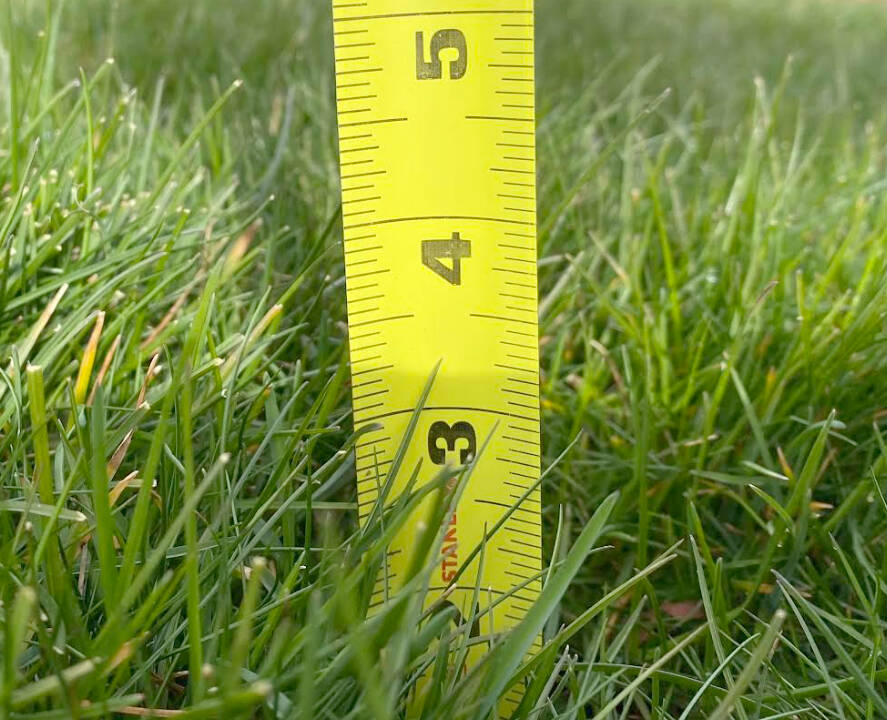A healthy, well cared for lawn is a wonderful thing! It beautifies the neighborhood, releases oxygen, prevents erosion, cools homes in the summer, and deters weeds and pests.
How grass is mowed has a dramatic impact on keeping a lawn vibrant. Here are some of the best practices on mowing:
Perhaps the best thing homeowners can do is to set the mower high. Most lawns on the Olympic Peninsula consist of a variety of cool-season grasses, such as perennial rye grasses and fescues. In this situation, cutting lawns to 3 inches tall is a solid strategy.
Cutting your grass tall has several surprising benefits. Grass stores most of its water in its blades. Taller grass stores significantly more water than shorter grass. This makes the grass more drought tolerant and you do not need to water as often.
Another surprising benefit is that tall grass has significantly greater root depth. Typically, roots grow 3 times as deep as the lawn is mowed tall. For example, lawns cut at 2 inches tall will have 6-inch deep roots while grass cut at 3 inches will have 9-inch deep roots!
These longer roots can gain greater access to moisture and nutrients that are deeper in the soil profile. The rhizome activity of grass roots is increased with deeper roots, creating a denser lawn. Denser turfs block out weeds better and yields a darker green color.
And one more benefit; wouldn’t you agree that taller grass is more pleasant to walk on with bare feet?
Getting that 3-inch tall cut may not be straightforward. Although most mowers have adjustable deck heights, the number on a deck settings may not indicate how high the grass will be cut. For example, a number 3 setting may not necessarily mean that the grass will be cut at 3 inches tall; consult your mower’s owner manual to learn what mower settings equate to in inches.
A quick remedy is to mow just a small portion of the turf at the highest setting to give your lawn the tallest height. Then, measure the height of your freshly-mown lawn with a ruler. Make adjustments as needed to achieve a 3-inch height.
Key lawn care
Here are a few more amazing mowing tips:
• Remember to mow only about one-third or less of the height of the grass at any one time. This is to prevent scalping. Scalping causes a brown appearance and depletes carbohydrate reserves in the grass. Such stress makes turf more susceptible to disease, pest and weed damage.
• Mow your lawn at least once a week during peak growing months. Regular, frequent mowing stimulates greater lateral shoot growth. That increases grass density and blocks weed seeds from germinating.
• Each time you mow your lawn, vary the mowing pattern with a slight overlap. If you went lengthwise last time, then go width-wise next time, and diagonally the following time to keep the grass blades from getting pushed over in the same direction. That will also minimize soil compaction.
• Mow your lawn when it is dry. You will get a more even cut with dry grass. Surprisingly, the best time to mow a lawn is early in the evening when the sun is less intense. The lawn will have plenty of time to recover overnight before the next afternoon’s heat arrives.
• Mulching grass clippings back into the lawn is highly beneficial! Mulched clippings break down and provide nutrients to the soil. Just rake up excess lawn clippings. Proper mulching does not cause thatch.
• Keep your mower blades sharp. Dull blades tear up grass and cause ragged, brown edges. This uneven cutting increases water loss and risk from disease. There are numerous videos available online that provide clear, step-by-step directions on how to sharpen mower blades.
Hopefully, these tips are helpful — particularly the one about mowing your lawn 3 inches or taller. Your grass will thank you by staying healthy and smiling with a lush, vibrant deep green color!
Happy mowing … and don’t forget hearing and eye protection.
For more information about lawn care, go to extension.wsu.edu/king/tip-sheet-11-lawns.
Final thought: Perhaps it is worth thinking that lawns are best suited to be small to medium-sized graceful carpets surrounded by planting beds instead of wall-to-wall carpeting.
Dave Eberle is a Clallam County Master Gardener intern.
Looking after lawns
This is the first article in a series of articles on lawn care that will be published in the Sequim Gazette this year. Look for the next article to spotlight electric mowers and conventional mowers. Subsequent articles will be on summer and fall care.


